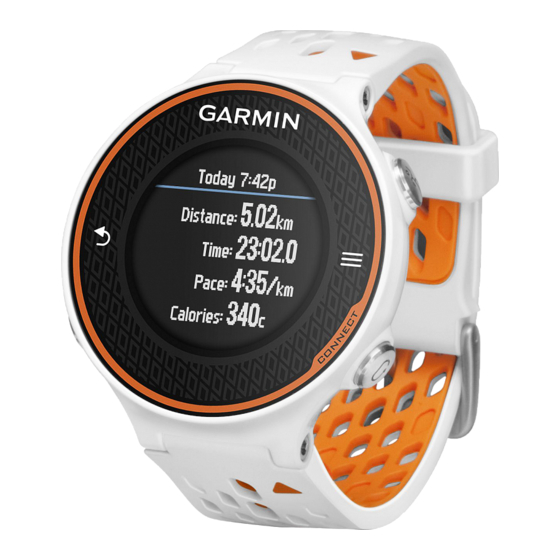Garmin Forerunner 620 Gebruikershandleiding - Pagina 11
Blader online of download pdf Gebruikershandleiding voor {categorie_naam} Garmin Forerunner 620. Garmin Forerunner 620 18 pagina's. Sports and fitness gps-devices
Ook voor Garmin Forerunner 620: Beknopte handleiding (25 pagina's), Snelstarthandleiding (24 pagina's)

Going for a Run Using a Foot Pod
Before you go for a run, you must pair the foot pod with your
device
(page
6).
You can run indoors using a foot pod to record pace, distance,
and cadence. You can also run outdoors using a foot pod to
record cadence data with your GPS pace and distance.
1
Install your foot pod according to the accessory instructions.
2
If necessary, turn off GPS
3
Select
to start the timer.
4
Go for a run.
5
After you complete your run, select
History
History includes time, distance, calories, average pace or
speed, lap data, and optional ANT+ sensor information.
NOTE: When the device memory is full, your oldest data is
overwritten.
Viewing History
1
Select
> History > Activities.
2
Scroll up and down to view your saved activities.
3
Select an activity.
4
Select an option:
• Select Details to view additional information about the
activity.
• Select Laps to select a lap and view additional
information about each lap.
• Select Delete to delete the selected activity.
Viewing Data Totals
You can view the accumulated distance and time data saved to
your device.
1
Select
> History > Totals.
2
Select an option to view weekly or monthly totals.
Deleting History
1
Select
> History > Options.
2
Select an option:
• Select Delete All Activities to delete all activities from
the history.
• Select Reset Totals to reset all distance and time totals.
NOTE: This does not delete any saved activities.
3
Confirm your selection.
Data Management
NOTE: The device is not compatible with Windows ® 95, 98,
Me, Windows NT ® , and Mac ® OS 10.3 and earlier.
Deleting Files
If you do not know the purpose of a file, do not delete it. Your
device memory contains important system files that should not
be deleted.
1
Open the Garmin drive or volume.
2
If necessary, open a folder or volume.
3
Select a file.
4
Press the Delete key on your keyboard.
History
(page
8).
to stop the timer.
NOTICE
Disconnecting the USB Cable
If your device is connected to your computer as a removable
drive or volume, you must safely disconnect your device from
your computer to avoid data loss. If your device is connected to
your Windows computer as a portable device, it is not
necessary to safely disconnect.
1
Complete an action:
• For Windows computers, select the Safely Remove
Hardware icon in the system tray, and select your device.
• For Mac computers, drag the volume icon to the trash.
2
Disconnect the cable from your computer.
Customizing Your Device
Setting Up Your User Profile
You can update your gender, birth year, height, weight, and
heart rate zone
(page
6) settings. The device uses this
information to calculate accurate training data.
1
Select
> Settings > User Profile.
2
Select an option.
Activity Settings
These settings allow you to customize your device based on
your training needs. For example, you can customize data
screens and enable alerts and training features.
Customizing the Data Screens
You can customize data screens based on your training goals
or optional accessories. For example, you can customize one of
the data screens to display your lap pace or heart rate zone.
1
Select
> Settings > Activity Settings > Data Screens.
2
Select a screen.
3
Select
> Status > On to enable the data screen.
4
Select a data field to change it.
Alerts
You can use alerts to train toward specific heart rate, pace,
time, distance, cadence, and calories goals and to set run/walk
time intervals.
Setting Range Alerts
A range alert notifies you when the device is above or below a
specified range of values. For example, if you have an optional
heart rate monitor, you can set the device to alert you when
your heart rate is below zone 2 and over zone 5
1
Select
> Settings > Activity Settings > Alerts.
2
Select the type of alert.
Depending on your accessories, the alerts may include heart
rate, pace, and cadence.
3
Turn on the alert.
For example, you must turn on the heart rate high alert
before you can select a zone or enter a custom heart rate
value.
4
Select a zone or enter a value for each alert.
Each time you exceed or drop below the specified range, a
message appears. The device also beeps or vibrates if audible
tones are turned on
(page
Setting a Recurring Alert
A recurring alert notifies you each time the device records a
specified value or interval. For example, you can set the device
to alert you every 30 minutes.
1
Select
> Settings > Activity Settings > Alerts.
2
Select Time, Distance, or Calories.
3
Turn on the alert.
(page
8).
6).
7
